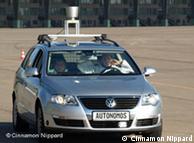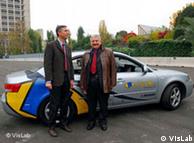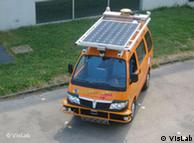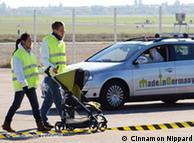Germany, US lead research into robotic cars

German research is at the forefront of autonomous driving
As the American state of Nevada legalizes autonomous vehicles,
researchers indicate that German and American corporate money is behind
most research into driverless cars.
Just last week, after some lobbying from Google, the American
state of Nevada became the first region of the US to authorize
autonomous cars on public roads. The Nevada Department of Transportation
is now tasked with adopting "regulations authorizing the operation of
autonomous vehicles on highways."
Google revealed last fall that it had been driving its driverless car
on Californian roads over 225,000 kilometers (140,000 miles) for many
months in 2010. That new law comes just after the world's top
researchers into these robotic cars gathered at a recent conference in
Baden-Baden, in southern Germany, to share their latest results.
The research into autonomous driving was kickstarted seven years ago,
when the US Department of Defense research agency, better known as
DARPA, created a desert road race for self-driving vehicles.
The race was tough - not one of the 15 competitors made it to the
finish line. Things have vastly improved since then though.
Today, kitted out with video cameras, radar sensors or laser range
finders, test cars are able to drive themselves through real city
traffic.
"It is a very surreal experience at first because you are sitting in
the driver's seat and so you are so used to having to control
everything," said Jesse Levinson, a researcher from Stanford University,
who attended the Baden-Baden conference and presented a paper.
"And then all of a sudden, the steering wheel is turning by itself
and the gas is being pressed by itself. And all of a sudden, you start
getting comfortable and you say, 'Hey, wait a second, my car is driving
and it is actually doing a really good job.'"
 Alberto Broggi (left) led a project to drive a car from Italy to China in 2010Levinson
added that autonomous cars with video cameras, computers and laser
sensors, are now better than humans at doing certain things on the road. Alberto Broggi (left) led a project to drive a car from Italy to China in 2010Levinson
added that autonomous cars with video cameras, computers and laser
sensors, are now better than humans at doing certain things on the road.
"It's even more accurate in staying in the middle of the lane, and it
is able to detect when a car in front of you brakes, even faster than a
human driver," he told Deutsche Welle. "It also has a better sense of
what's going on behind itself than a person."
Autonomous cars not perfect yet
Despite their high-tech equipment though, self-driving vehicles still
fail dismally in certain situations. In extremely heavy rain or when
there is a lot of dust for example, the cameras just can't see the road.
It is possible to circumvent this with special sensors, called laser
radar sensors, or ladars, in short.
Of course, ladar doesn't actually "see" anything, rather it scans and
processes the echoes bounced off targets. But ladar brings difficulties
of its own, explained Alberto Broggi, a computer scientist from the
University of Parma.
"It is getting pretty common to have a one of these quite expensive
sensors on top of your car that is able see everything around you; the
front, back, the sides, very far away," he said. "The problem is to
process this data. Because it is a huge amount of data. And you have to
understand every single echo from this system and classify that."
Last year, Broggi's research team tested an autonomous vehicle over a
staggering 30,000 kilometers (18,600 miles) , taking it from Italy to
China. Broggi says that the logical computers driving the car were
completely overwhelmed when humans drove chaotically – a common scenario
in huge and sometimes unruly cities like Moscow or Shanghai.
 Broggi said that Moscow traffic frustrated the autonomous driving softwareHe
noted that's why artificial intelligence researchers like Broggi are
now focusing on improving the way the data from the sensors is
processed. But, the data itself can be overwhelming. Broggi said that Moscow traffic frustrated the autonomous driving softwareHe
noted that's why artificial intelligence researchers like Broggi are
now focusing on improving the way the data from the sensors is
processed. But, the data itself can be overwhelming.
"We secured some 20,000 hours on the largest supercomputer in Italy,
so now we have a huge amount of data because we collected every single
bit that came out of the sensors and from GPS and from radios," he said.
Broggi expects to spend the next three years at his desk crunching numbers.
"The idea is to process the data, find out what didn't work, then go
back to the laboratory and fix the issues, fix the software, make
changes and then process it again, and then you hopefully get a smaller
amout of data that doesn't work, then we will start working on that
again," he said. "And then we will process and process again the same
data until we get some software that can process everything 100 percent
reliable."
Elements of driverless robotics are already available
While completely autonomous cars are still in the testing phase, some
spinoffs can already be found in commercially-available vehicles.
 Autonomous cars are designed to stop for pedestriansMany
German carmakers such as Daimler, BMW, Volkswagen and Audi as well
as companies associated with the automotive industry, such as Bosch,
have been quietly pushing this type of research in Europe. With some
serious money being thrown at the technology, as well as backing from
Google which is testing its own fleet of autonomous cars in the United
States, many experts predict it won't be too long before self-driving
vehicles hit the streets. Autonomous cars are designed to stop for pedestriansMany
German carmakers such as Daimler, BMW, Volkswagen and Audi as well
as companies associated with the automotive industry, such as Bosch,
have been quietly pushing this type of research in Europe. With some
serious money being thrown at the technology, as well as backing from
Google which is testing its own fleet of autonomous cars in the United
States, many experts predict it won't be too long before self-driving
vehicles hit the streets.
At the intelligent vehicle conference, Joachim Happ, a Mercedes
engineer, who took people on a drive in a simulator showing them
so-called driver-assist technology that is already available in top-end
Mercedes cars.
"My desire is to drive fast, for example, at 150 kilometers an hour,
but there is a car ahead of me only driving 120, then it autonomously
reduces the speed, by throttling the engine, or if necessary even
braking by itself," he explained. "If the driver unattentively leaves
the lane, we already have an algorithim pushing him or her back into the
desired lane."
Author: Kate Hairsine, Baden-Baden / cjf
Editor: Nicole Goebel
http://www.dw-world.de/dw/article/0,,15194126,00.html
| 








